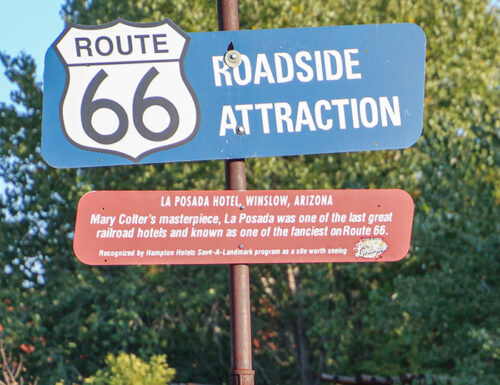Route 66 Roadside Attraction Signs
When you travel down Route 66 you will most likely see a variety of “Roadside Attraction Signs”. These signs typically highlight places of interest along the Mother Road. When you see them, you’ll find them helpful during your trip. But, you may wonder, how did those signs get there and who put them there? We’re going to answer that in this article.
In the historical Route 66 community, it was becoming apparent that signage along the route was lacking. Tourists would travel down the road and not realize what occurred in history at different places. A solution to helping tourists learn about the historical sites along Route 66 was needed.
Several organizations have already been putting up signs at various place, but there was no consistency across the whole road. Hampton Inn was already placing signs due to various preservation projects that they were promoting. They recognized the value in applying such preservation projects to Route 66 and placing signs that consistently looked the same across the entire length of Route 66.
Around 2001, the Hampton Inn folks contacted Route 66 aficionado and preservationist Jim Conkle and asked him if he could help with identifying sites where these signs could be placed. Jim obliged and took on the assignment.

Jim Conkle standing next to a Roadside Attraction sign at La Posada, Winslow, AZ
At first, it was decided to erect few signs and perform a some preservation projects, such as restoring historical landmarks. After seeing the positive results of these projects, Hampton Inn decided to get involved with placing more signs. This turned into placing 66 signs along the entirety of Route 66.
With Jim help, 66 sites were identified to place signs, along with what would be said on the signs. Essentially, these signs would serve as classic historical markers of interesting places along the road.

Jim Conkle standing next to a Roadside Attraction sign at La Posada, Winslow, AZ
In April 2002, Jim and his good friend Guy Randall led a 66-day caravan from “pier to pier” – Santa Monica to Chicago – posting “Roadside Attraction” signs highlighting special sites, treasured landmarks and vintage establishments along the 2,448-mile historical route. The signs will now serve as a permanent guide for future travelers who want to know where to stop and take in the road’s unique history.
As mentioned, along with placing the signs, various preservation project were done. One was restoring the largest map of Route 66 by the artist Bob Waldmire that was at Meteor City Trading Most outside of Winslow, Arizona. Another was restoring the oldest house in America along an old alignment of Route 66 in Santa Fe, NM. All of these efforts were supported by Hampton Inn.

